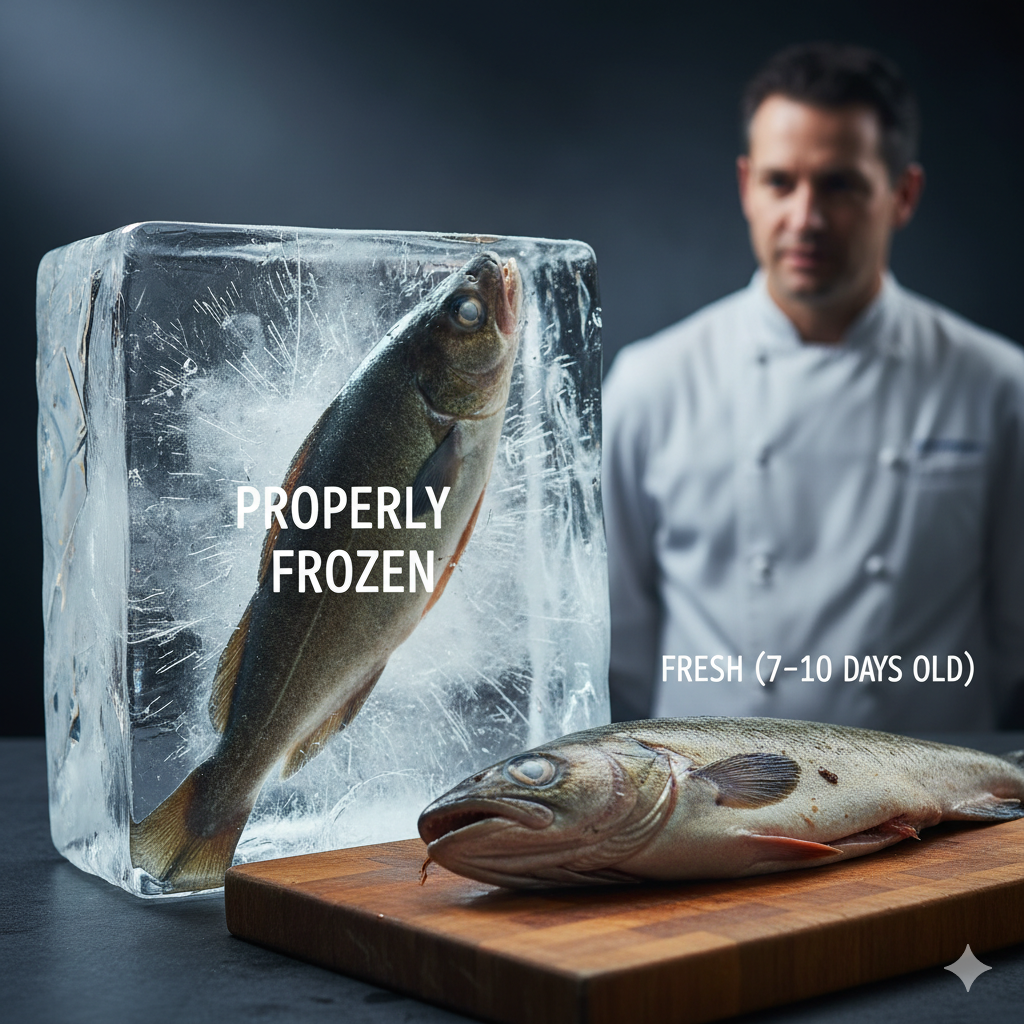Introduction: The Big Misunderstanding
Ask a hundred diners what the opposite of fresh fish is, and ninety-nine will say frozen. That answer is wrong. Dead wrong. The opposite of fresh fish is rotten fish. Frozen fish, when handled right, can actually be fresher than what’s sold across the counter as “fresh.”
I’ve built my career as a chef, a food activist, and a student of quality ingredients. And I’ve seen firsthand that frozen fish is misunderstood, misrepresented, and underestimated. This paper is meant to flip that narrative. If you care about food quality, safety, sustainability, and flavor, it’s time to rethink what “fresh” really means.
The Romance of Fresh Fish — and the Reality Behind It
We love the romantic notion: a fisherman goes out at dawn, catches a glistening halibut, and by dinner that fish is sitting on a plate in front of you. It happens — but rarely.
The truth is, most “fresh” fish takes a long road to your plate:
- Caught offshore, often days into a multi-day fishing trip.
- Stored on ice in the hold of a boat.
- Offloaded to a processor or distributor.
- Trucked or flown into warehouses.
- Finally delivered to markets and restaurants.
By the time you see that fish in the display case, it may already be 7–10 days old. And that’s if handling was perfect. If temperatures fluctuated, if ice melted, or if transport lagged — the clock is ticking faster than you realize.
Meanwhile, properly frozen fish — frozen on the boat or within hours at the dock — can taste like it just came out of the water. Time stops the moment that fish hits the blast freezer.
How Long Does Fresh Fish Really Last?
The industry loves to generalize: “fresh fish lasts a week.” But here’s the deeper truth:
- Delicate or oily species like shrimp, lobster, squid, mackerel, sardines, and bluefish → 3–5 days max. Their fat content and fragile proteins break down quickly, and they oxidize into off flavors.
- Moderate species like salmon, trout, or swordfish → 5–10 days under good handling.
- Lean whitefish like tilapia, haddock, halibut, or cod → 10–21 days if iced perfectly and handled meticulously.
I once ran my own experiment: carefully storing tilapia under pristine conditions for three weeks. At day 21, it was still clean, firm, and serviceable. Would I recommend every fish be held that long? Absolutely not. But it proves the point: handling and species matter far more than a simplistic “fresh vs. frozen” label.
Scallops and the Aroma Exception
Here’s a fun fact: the only seafood that should smell sweet is scallops. That natural sugary aroma is a hallmark of their freshness. For almost every other fish, odor is a red flag.
Fish should never smell “fishy.” A good fish market should smell like ocean air — briny, clean, refreshing. The moment a whiff makes you wrinkle your nose, you’re smelling spoilage. Frozen fish, thawed properly, gives off no odor at all. That’s another advantage worth educating people about.
The Sushi Surprise: Why Frozen is the Law
One of the most surprising facts for diners: that melt-in-your-mouth slice of sushi you just ate was likely frozen first.
The FDA requires that fish served raw (with certain exceptions like farmed salmon or shellfish) be frozen to kill parasites. Some states, like New Jersey, make this a legal mandate. Freezing isn’t just acceptable in sushi — it’s a safety protocol.
And yet, sushi is the gold standard for seafood dining. If the highest expression of fish — sashimi, nigiri, crudo — often begins frozen, doesn’t that say something? It says that frozen can be not just safe but premium.
Blind Tasting at the Culinary Institute of America
Years ago, I attended a Sustainable Food Conference at the Culinary Institute of America. One session hosted a blind tasting: chefs were served both fresh and properly frozen fish, asked to evaluate texture, flavor, aroma.
The results? Chefs couldn’t tell the difference. In some cases, frozen fish was preferred.
That’s the smoking gun. If trained chefs can’t consistently distinguish fresh from frozen when freezing is done right, why should we cling to the myth that frozen is lesser?
Bruce Gore and Triad Fisheries: Setting the Standard
If you want proof that frozen can be world-class, look to Alaska. Fisherman Bruce Gore pioneered a system where fish are caught on longlines, bled, dressed, and individually blast-frozen at sea within hours.
His company, Triad Fisheries, sells sablefish (black cod) and salmon that rival anything you can imagine. The Japanese sushi market — perhaps the most quality-obsessed buyers in the world — consistently purchases Gore-frozen fish. That alone proves the point: frozen done right is not just acceptable, it’s elite.
Fresh vs. Frozen: Side-by-Side Comparison
| Factor | “Fresh” (Unfrozen) Fish | Properly Frozen Fish |
| Shelf Life | 3–21 days depending on species and handling (lean whitefish last longest; oily/delicate species shortest) | Months to over a year |
| Parasite Risk | Higher | Eliminated by freezing |
| Consistency | Variable; handling and transport matter enormously | Consistent, peak quality locked in |
| Aroma | May develop “fishy” odor quickly | Neutral, clean upon thaw |
| Availability | Limited by season and geography | Year-round access to peak season catch |
| Waste Factor | Higher spoilage and loss | Lower waste, better portion control |
Fat Content, Texture, and Science in Play
Why do some fish last longer? It comes down to fat content, enzymatic activity, and oxidation.
- Oily fish like mackerel and bluefish → oxidize rapidly, producing rancid flavors.
- Shellfish like shrimp and lobster → their delicate proteins denature quickly, causing mushiness.
- Lean species → slower oxidation, firmer muscle tissue, longer life span.
Freezing interrupts all of these pathways. Enzymatic breakdown? Stopped. Oxidation? Paused. Texture change? Minimized when frozen quickly with modern technology.
The Environmental and Economic Benefits
Frozen seafood is also sustainable seafood:
- Less waste → Fishermen can freeze excess catch instead of dumping it or racing to sell it before it spoils.
- Better economics → Restaurants can buy in volume without fear of loss, and offer specials without gambling on perishability.
- Access for consumers → Diners in Kansas or Colorado can enjoy Alaskan salmon or Chilean sea bass at peak quality.
Think about the environmental impact of tossing spoiled fish. Freezing is a tool against waste, and that’s good for the planet.
Nutrient Retention: Busting Another Myth
A common claim: frozen fish loses nutrients. The truth: multiple studies show frozen fish retains vitamins, minerals, and omega-3 fatty acids as well or better than “fresh” fish that’s been sitting for 10 days.
The real nutrient loss comes from time, not from freezing. Quick-freeze technology locks in the nutritional profile just like it locks in texture and flavor.
Practical Culinary Guidance
So how do you judge quality? Whether buying fresh or frozen, here’s what matters:
- Fresh (unfrozen) whole fish: clear eyes, firm flesh, no odor, bright red gills.
- Frozen fish: look for vacuum-sealed packaging, no ice crystals, no freezer burn. A thin glaze of ice is good — it protects the fish.
In the kitchen:
- Use frozen fish for dishes where texture isn’t the star — soups, chowders, braises.
- Use properly frozen-at-sea fish confidently for sushi, crudo, and fine dining.
- Be transparent. Diners respect chefs who explain why frozen was the better choice for that fish.
Changing the Narrative: Education is the Key
The obstacle isn’t the product. It’s perception. Diners have been taught that frozen equals cheap, inferior, or mass-market. But the real conversation should be about handling, timing, and respect for the catch.
As chefs, fishmongers, and educators, we need to tell these stories. Explain that freezing is a tool of respect, not a shortcut. Share examples like Bruce Gore’s fish, or the FDA sushi laws. Give guests the confidence that frozen doesn’t mean worse — it means smarter.
Conclusion: Freshness, Redefined
The seafood industry needs a reframing. Fresh fish is only as good as its handling. Frozen fish, when done properly, can be fresher than fresh — safer, more sustainable, and more consistent.
So the next time someone asks whether your fish is fresh or frozen, you can smile and say:
“It’s the best quality available. Fresh when it counts, frozen when it makes it better.”
Because the real enemy of seafood isn’t frozen. The real enemy is neglect.








